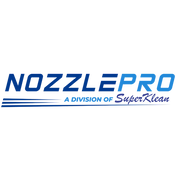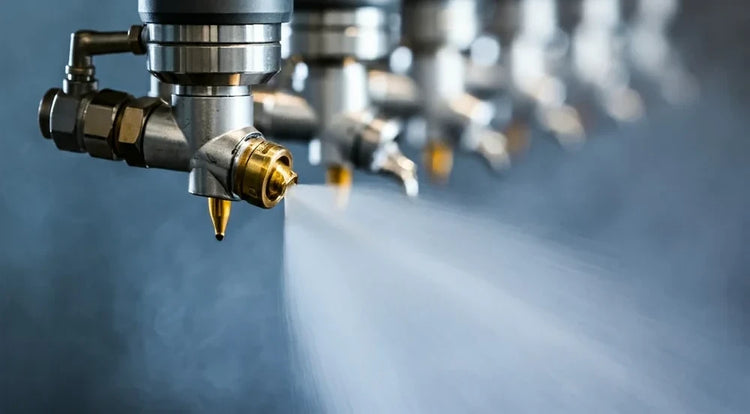To view pricing, please fill the form added below.
Already have an account? Please Login here.Conveyor & Belt Cleaning Systems for Mining Operations
High-performance belt wash systems removing material buildup, fines, and contamination from mining conveyors—reduce maintenance costs 30–50%, prevent cross-contamination, eliminate unplanned downtime, and optimize material throughput with engineered spray technology and self-cleaning nozzle systems.
Conveyor Cleaning Challenges in Mining
Mining conveyors operating 24/7 under heavy loads transport ore, coal, aggregates, and overburden through harsh environments where material buildup, carryback, and contamination create persistent operational challenges. Accumulated fines (20–200 mesh particles) adhere to belt surfaces, embed in roller grooves, and coat support structures—causing increased power consumption, accelerated belt wear, reduced material flow capacity, cross-contamination between ore grades, dust generation, spillage incidents, and unplanned maintenance shutdowns costing $5,000–50,000 per hour in lost production.
Common Problems from Poor Belt Cleaning:
- Material Carryback: Sticky clays and fines adhere to return belt surfaces accumulating in idler grooves
- Belt Tracking Issues: Uneven material buildup causes belt misalignment and edge wear
- Bearing Failure: Compacted material in roller housings accelerates bearing wear and seizure
- Cross-Contamination: Residual material from previous loads contaminates ore grades
- Reduced Throughput: Material accumulation reduces effective belt width and capacity
- Fugitive Dust: Inadequate cleaning at transfer points increases emissions and operator exposure
- Safety Hazards: Spillage creates slip/trip hazards and increases unplanned downtime
Five-Zone Integrated Washing System
NozzlePro engineers precision conveyor wash systems combining optimized spray nozzles, manifold positioning, and water management to deliver continuous or intermittent cleaning across belt widths of 600–3,000mm, removing sticky clays, adherent fines, and encrusted material without excessive water usage or belt damage. Our cleaning systems operate at 3–80 bar pressure, consuming 10–500 liters per minute while achieving 90–99% material removal efficiency—supporting mines processing 500–20,000 tons per hour across surface operations, underground mines, coal preparation plants, mineral processing facilities, and aggregate quarries.
1. Primary Discharge Wash
Pressure: 8–30 bar | Flow: 50–300 L/min
Nozzle: Wide-angle flat fan (60–110°)
Primary washing system positioned at discharge point removes adherent material, sticky clays, and compacted fines from belt carrying surface. Complete belt width coverage prevents spillage and material loss while improving downstream cleaning efficiency.
2. Return Belt Cleaning
Pressure: 3–12 bar | Flow: 20–100 L/min
Nozzle: Full cone / hollow cone arrays
Secondary cleaning targets return belt surfaces and idler rollers, removing residual fines and preventing material accumulation in roller grooves that causes belt tracking problems and premature bearing failure.
3. Scraper Pre-Wetting
Pressure: 5–15 bar | Flow: 10–50 L/min
Nozzle: Fine spray / flat fan
Precision spray nozzles pre-wet adherent materials upstream of mechanical scrapers, reducing blade loading, minimizing contact pressure, and extending blade life significantly while improving scraper efficiency.
4. Idler & Roller Cleaning
Pressure: 6–20 bar | Flow: 30–150 L/min
Nozzle: Full cone spray arrays
Integrated idler spray systems maintain roller cleanliness throughout return side, preventing material accumulation that affects bearing performance, belt alignment, and equipment longevity.
5. Dust Suppression System
Pressure: 3–8 bar + compressed air
Nozzle: Air-atomizing / fine mist
Air-atomizing spray systems suppress fugitive dust at transfer points, prevent material carryover, maintain operator visibility, and support MSHA compliance requirements while improving material containment.
Automatic Self-Cleaning Nozzle Systems
Self-cleaning spray nozzles eliminate manual purging, reduce downtime for nozzle maintenance, and maintain performance in harsh mining environments where clogging from sediment, mineral scaling, and fine particles degrades cleaning effectiveness.
Self-Cleaning Technology Benefits:
- Automatic Purging: Built-in check valves and reverse-flow ports automatically purge sediment when system pressure drops or cycles
- Reduced Clogging: 40–60% reduction in clogging incidents in dirty water systems
- Extended Service Life: 2–3 months longer operation per nozzle vs. standard designs
- Continuous Operation: Maintains performance in coal fines, iron ore dust, and calcium scaling environments
- Lower Maintenance: Eliminates 1–4 manual purge cycles per shift in mineral processing applications
ROI Impact of Self-Cleaning Nozzles
Traditional nozzles require manual purging 1–4 times per shift in coal/mineral processing operations. Each purge cycle = 15–30 minutes downtime. Self-cleaning nozzles eliminate manual intervention, maintain consistent spray performance, and reduce maintenance labor cost $500–5,000 annually per conveyor system.
Typical ROI: $2,000–6,000 nozzle upgrade pays for itself in 30–60 days through labor savings and reduced downtime.
Operational Benefits & Performance Metrics
- Material Carryback Elimination: Precision spray systems remove 90–99% of adherent material from belt surfaces
- Extended Belt Life: Complete cleaning reduces abrasive wear extending belt service life 40–60% from 18–24 months to 30–40 months
- Reduced Maintenance Costs: Preventing material buildup decreases bearing failures, tracking issues, and mechanical problems 30–50%
- Cross-Contamination Prevention: Effective belt cleaning maintains metallurgical specifications and product value between ore grades
- Increased Throughput: Clean belts maintain design capacity preventing carryback that reduces effective belt width
- Improved Safety: Eliminating spillage reduces slip/trip hazards, minimizes airborne dust exposure, and maintains MSHA compliance
- Lower Power Consumption: Clean idlers and reduced belt resistance decrease motor loads 5–15% compared to fouled conveyors
- Water Conservation: Optimized spray patterns and automated controls reduce water consumption 40–70% vs. excessive spray systems
Material-Specific Cleaning Applications
Coal & Lignite Operations
Moisture content (5–35%) and fine particle adhesion cause significant carryback on belt surfaces. Moderate-pressure systems (8–20 bar) with wide-angle nozzles provide effective cleaning without excessive water addition affecting downstream processing. Spray activation synchronized with belt speed optimizes both cleaning and water efficiency.
Iron Ore & Taconite Processing
High-density materials (4.5–5.2 specific gravity) with adherent fines require higher impact forces for effective removal. Pressure range 12–40 bar with hardened nozzles resistant to abrasive wear. Complete cleaning prevents material oxidation on belt surfaces affecting metallurgical properties and product specifications.
Clay-Rich & Sticky Ore Streams
Sticky clays with high plasticity index create most challenging cleaning applications. High-pressure systems (30–80 bar) with extended dwell time (pre-wetting + primary wash + rinse) required for complete removal. Warm water systems (40–60°C) improve cleaning effectiveness in cold climates by reducing clay viscosity significantly.
Aggregates & Crushed Stone
Low-moisture materials with minimal adhesion cleaned effectively at lower pressures (3–12 bar). Simple systems with motion-activated spray provide adequate cleaning while minimizing water consumption. Primary focus on removing fines that cause dust generation and accumulate in transfer points.
Engineering Design & Optimization
Application-Specific System Optimization
NozzlePro engineers conveyor cleaning systems by analyzing material characteristics (particle size, moisture content, clay content, adhesion properties), belt specifications (width, speed, load), and operational constraints (water availability, temperature, environmental regulations) to optimize spray coverage, impact force, water consumption, and cleaning effectiveness.
Critical Design Parameters:
- Coverage Uniformity: Nozzle selection and spacing provide complete belt width coverage with ±10% impact force variation
- Impact Force Optimization: Pressure (3–80 bar) and nozzle selection deliver 5–40 N/cm² impact forces sufficient for material dislodgement
- Spray Angle Matching: Nozzle spray angle coordinated with mounting distance ensures proper belt coverage
- Water Quality Management: Filtration systems (100–500 µm) prevent nozzle plugging from mine water contaminants
- Material-Specific Adjustment: System pressure and flow optimized for specific materials and moisture content
- Automation Integration: Motion sensors, flow meters, and PLC controls reduce water usage 40–70% during variable production
- Wear-Resistant Materials: Hardened stainless steel, tungsten carbide, or ceramic nozzles extend service life 5,000+ hours
Application-Specific Parameters
| Application | Nozzle Type | Pressure Range | Flow Rate | Notes |
|---|---|---|---|---|
| Primary Belt Wash (Carrying Surface) | Wide-angle flat fan | 8–30 bar | 50–300 L/min | Complete belt width coverage, maximum carryback removal |
| Return Belt Cleaning | Full cone / Hollow cone | 3–12 bar | 20–100 L/min | Idler and pulley coverage, prevents accumulation |
| Scraper Pre-Wetting | Flat fan (fine spray) | 5–15 bar | 10–50 L/min per meter | Upstream nozzle positioning, blade efficiency improvement |
| Transfer Point Dust Suppression | Air-atomizing / Fine mist | 3–8 bar water + air | 5–30 L/min | MSHA compliance, fugitive emission control |
| Heavy Clay Removal | High-pressure flat fan | 20–80 bar | 80–400 L/min | Extended dwell time, warm water systems recommended |
| Roller & Idler Cleaning | Full cone arrays | 6–20 bar | 30–150 L/min per zone | Periodic maintenance, bearing protection focus |
Water Conservation & Environmental Compliance
Optimized Water Management
Modern conveyor washing systems optimize water consumption through intelligent nozzle selection, spray pattern design, and automated activation. Motion sensors trigger cleaning only during active material transport, reducing unnecessary water spray during idle periods. Proper filtration systems (100–500 µm) enable recirculation of wash water, reducing consumption 40–70% compared to single-pass systems while maintaining cleaning performance.
Recirculated Water Systems
Recirculated wash water (filtered but still containing fine abrasive particles) requires specialized nozzle designs with larger internal passages, anti-sludge geometry, and hardened materials. These specialized nozzles tolerate high-sediment recirculated water extending service life 6–12 months versus 1–2 months for standard designs in mining applications.
Environmental Compliance
Effective conveyor cleaning reduces fugitive dust emissions 80–95%, supporting MSHA compliance requirements and improving site environmental performance. Dust suppression systems at transfer points capture airborne particles maintaining operator visibility while reducing worker exposure to hazardous materials.
Get Your Conveyor Cleaning Solution
NozzlePro engineers custom conveyor washing systems optimized for your specific material type, belt specifications, production rate, and operational constraints. Our team analyzes your material characteristics (particle size distribution, moisture content, clay percentage), belt parameters (width, speed, load capacity), water quality, and site requirements to provide detailed manifold layouts, hydraulic calculations, water consumption estimates, and ROI projections specific to your operation.
Key Information
System Integration
Five zones work sequentially: pre-wetting softens materials, primary discharge removes bulk carryback, return cleaning prevents accumulation, idler maintenance prolongs bearing life, dust suppression maintains compliance and safety.
Performance Metrics
90–99% carryback removal, 30–50% maintenance cost reduction, 40–60% belt life extension, 5–15% power consumption decrease, 80–95% dust suppression effectiveness, complete operational optimization.
Self-Cleaning Benefits
Automatic purge systems eliminate 40–60% clogging in dirty water applications. Reverse-flow ports prevent sediment accumulation extending service life 2–3× in harsh mining environments.
Water Efficiency
Motion-sensor activation and optimized spray patterns reduce water consumption 40–70% versus continuous systems. Recirculated water with proper filtration maintains efficiency while reducing operating costs.
Material-Specific Design
Coal: 8–20 bar. Iron ore: 12–40 bar. Sticky clays: 20–80 bar. System optimization depends on moisture content, adhesion properties, particle size, and belt speed for maximum effectiveness.
Custom Engineering
NozzlePro engineers each system for your material characteristics, belt specifications, production rate, and site constraints. Detailed analysis includes manifold layouts, hydraulic calculations, and ROI projections.

